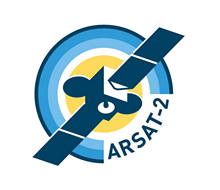
Ariane 5 is a European heavy-lift space launch vehicle developed and operated by Arianespace for the European Space Agency (ESA). It is launched from the Centre Spatial Guyanais (CSG) in French Guiana. It has been used to deliver payloads into geostationary transfer orbit (GTO) or low Earth orbit (LEO). The launch vehicle had a streak of 82 consecutive successful launches between 9 April 2003 and 12 December 2017. Since 2014, Ariane 6, a direct successor system, is in development.

The Guiana Space Centre, also called Europe's Spaceport, is a European spaceport to the northwest of Kourou in French Guiana, a region of France in South America. Kourou is located approximately 310 mi (500 km) north of the equator at a latitude of 5°. In operation since 1968, it is a suitable location for a spaceport because of its equatorial location and open sea to the east.

The Arab Satellite Communications Organization is a communications satellite operator in the Arab World, headquartered in the city of Riyadh, Saudi Arabia. Arabsat was created to deliver satellite-based, public and private telecommunications services to the Arab States, in accordance with International Standards. With 21 member countries, the organization plays a vital role of enhancing communications in the Arab World.
The A2100 is a model of communications satellite spacecraft made by Lockheed Martin Space Systems. It is used as the foundation for telecommunications payloads in geosynchronous orbit, as well as GOES-R weather satellites and GPS Block IIIA satellites. Over 40 satellites use the A2100 bus.
The Broadcasting Satellite System Corporation (B-SAT) is a Japanese corporation established in April 1993 to procure, manage and lease transponders on communications satellites. Its largest stockholder, owning 49.9%, is NHK, the Japan Broadcasting Corporation. In 1994, it was ranked by Space News as the world's 19th largest fixed satellite operator.
Galaxy 11 is an American geostationary communications satellite which is operated by Intelsat. It is located in geostationary orbit at a longitude of 32.8 degrees east, where it serves as a backup to the Intelsat 802 spacecraft. It was originally operated at 99° West and later spent most of its operational life at 91° West, from where it was used to provide communications services to Brazil and North America.
JCSAT-110, also known as N-SAT 110, JCSAT-7, Superbird-5 and Superbird-D, is a Japanese geostationary communications satellite which was operated by JSAT Corporation and Space Communications Corporation until both companies merged into SKY Perfect JSAT Group in 2008. It is positioned in geostationary orbit at a longitude of 110° East, from where it is used to provide communications services to Japan.
Arabsat-5A is a Saudi Arabian communications satellite operated by Arabsat. It will be used to provide television, internet and telephone services to Arabia, Africa and Europe.

Inmarsat-4A F4, also known as Alphasat and Inmarsat-XL, is a large geostationary communications I-4 satellite operated by United Kingdom-based Inmarsat in partnership with the European Space Agency. Launched in 2013, it is used to provide mobile communications to Africa and parts of Europe and Asia.

ARSAT-2 is a geostationary communications satellite operated by ARSAT and built by the Argentine company INVAP. It was launched from French Guiana alongside Sky Muster satellite using an Ariane 5ECA rocket on September 30, 2015 at 20:30hs UTC, becoming the 400th satellite to be launched by Arianespace. It is licensed to be located at 81° West longitude geostationary slot. ARSAT-2 is the second geostationary satellite built in Argentina, after ARSAT-1. Structurally and mechanically it is a copy of the ARSAT-1, the only difference being the payload and thus it has different antenna configuration.
BSAT-3a, is a geostationary communications satellite operated by Broadcasting Satellite System Corporation (B-SAT) which was designed and manufactured by Lockheed Martin on the A2100 platform. It is stationed on the 110,0° East orbital slot with its companion BSAT-3b and BSAT-3c from where they provide redundant high definition direct television broadcasting across Japan.
BSAT-3b, is a geostationary communications satellite operated by Broadcasting Satellite System Corporation (B-SAT) which was designed and manufactured by Lockheed Martin on the A2100 platform. It is stationed on the 110.0° East orbital slot along its companion BSAT-3a and BSAT-3c from where they provide redundant high definition direct television broadcasting across Japan.
BSAT-3c, also known as JCSAT-110R, is a geostationary communications satellite operated by Broadcasting Satellite System Corporation (B-SAT) and SKY Perfect JSAT (JSAT) which was designed and manufactured by Lockheed Martin on the A2100 platform.

JCSAT-17 is a geostationary communications satellite operated by SKY Perfect JSAT Group. The satellite was designed and manufactured by Lockheed Martin Space on the LM-2100 platform, and was launched on 18 February 2020 on an Ariane 5. The satellite mainly provides service to Japan and the surrounding regions. Utilizing several S-band transponders with a flexible processor, the satellite has the capability to redirect communications capacity to concentrate on disaster relief efforts or other high-volume events.

Arabsat-6A is a geostationary communications satellite operated by Arabsat. The satellite was built by Lockheed Martin Space Systems on a modernized A2100 bus. The satellite was successfully launched from Kennedy Space Center LC-39A aboard Falcon Heavy on April 11, 2019.

Ariane flight VA241 was an Ariane 5 space launch that occurred from the Guiana Space Centre on 25 January 2018 at 22:20 UTC.

GSAT-31 is a high-throughput telecommunication satellite developed by the Indian Space Research Organisation (ISRO).








